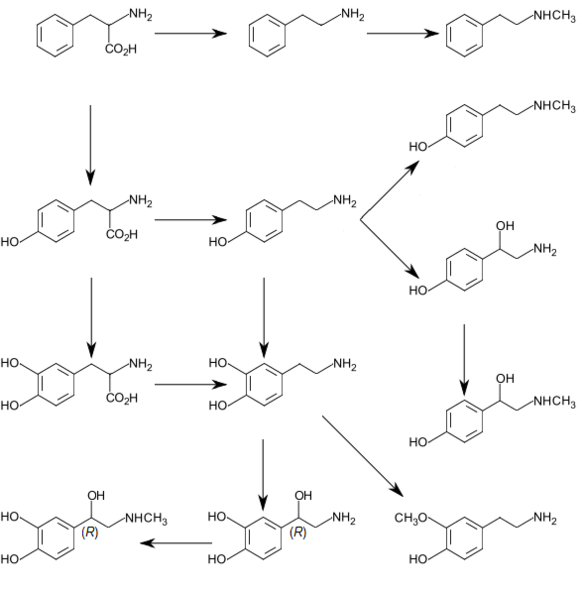N-Metiltiramin

| |
| Identifikacija | |
|---|---|
3D model (Jmol)
|
|
| ChEBI | |
| ChemSpider | |
| ECHA InfoCard | 100.006.120 |
| |
| Svojstva | |
| C9H13NO | |
| Molarna masa | 151,206 |
Ukoliko nije drugačije napomenuto, podaci se odnose na standardno stanje materijala (na 25 °C [77 °F], 100 kPa). | |
| Reference infokutije | |
N-Metiltiramin je organsko jedinjenje, koje sadrži 9 atoma ugljenika i ima molekulsku masu od 151,206 Da.
Sinteza[уреди | уреди извор]
Osobine[уреди | уреди извор]
| Osobina | Vrednost |
|---|---|
| Broj akceptora vodonika | 2 |
| Broj donora vodonika | 2 |
| Broj rotacionih veza | 3 |
| Particioni koeficijent[6] (ALogP) | 1,4 |
| Rastvorljivost[7] (logS, log(mol/L)) | -2,0 |
| Polarna površina[8] (PSA, Å2) | 32,3 |
Reference[уреди | уреди извор]
- ^ Li Q, Cheng T, Wang Y, Bryant SH (2010). „PubChem as a public resource for drug discovery.”. Drug Discov Today. 15 (23-24): 1052—7. PMID 20970519. doi:10.1016/j.drudis.2010.10.003.
- ^ Evan E. Bolton; Yanli Wang; Paul A. Thiessen; Stephen H. Bryant (2008). „Chapter 12 PubChem: Integrated Platform of Small Molecules and Biological Activities”. Annual Reports in Computational Chemistry. 4: 217—241. doi:10.1016/S1574-1400(08)00012-1.
- ^ Broadley KJ (2010). „The vascular effects of trace amines and amphetamines”. Pharmacol. Ther. 125 (3): 363—375. PMID 19948186. doi:10.1016/j.pharmthera.2009.11.005.
- ^ Lindemann L, Hoener MC (2005). „A renaissance in trace amines inspired by a novel GPCR family”. Trends Pharmacol. Sci. 26 (5): 274—281. PMID 15860375. doi:10.1016/j.tips.2005.03.007.
- ^ Wang X, Li J, Dong G, Yue J (2014). „The endogenous substrates of brain CYP2D”. Eur. J. Pharmacol. 724: 211—218. PMID 24374199. doi:10.1016/j.ejphar.2013.12.025.
- ^ Ghose, A.K.; Viswanadhan V.N. & Wendoloski, J.J. (1998). „Prediction of Hydrophobic (Lipophilic) Properties of Small Organic Molecules Using Fragment Methods: An Analysis of AlogP and CLogP Methods”. J. Phys. Chem. A. 102: 3762—3772. doi:10.1021/jp980230o.
- ^ Tetko IV, Tanchuk VY, Kasheva TN, Villa AE (2001). „Estimation of Aqueous Solubility of Chemical Compounds Using E-State Indices”. Chem Inf. Comput. Sci. 41: 1488—1493. PMID 11749573. doi:10.1021/ci000392t.
- ^ Ertl P.; Rohde B.; Selzer P. (2000). „Fast calculation of molecular polar surface area as a sum of fragment based contributions and its application to the prediction of drug transport properties”. J. Med. Chem. 43: 3714—3717. PMID 11020286. doi:10.1021/jm000942e.
Literatura[уреди | уреди извор]
- Clayden, Jonathan; Greeves, Nick; Warren, Stuart; Wothers, Peter (2001). Organic Chemistry (I изд.). Oxford University Press. ISBN 978-0-19-850346-0.
- Smith, Michael B.; March, Jerry (2007). Advanced Organic Chemistry: Reactions, Mechanisms, and Structure (6th изд.). New York: Wiley-Interscience. ISBN 0-471-72091-7.
- Katritzky A.R.; Pozharskii A.F. (2000). Handbook of Heterocyclic Chemistry (Second изд.). Academic Press. ISBN 0080429882.

